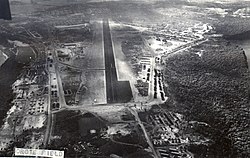Orote Field
Orote Field | |
 Orote Field in 1945 | |
 | |
| Location | Orote Peninsula, Naval Base Guam |
|---|---|
| Nearest city | Santa Rita, Guam |
| Coordinates | 13°26′13″N 144°38′30″E / 13.43694°N 144.64167°ECoordinates: 13°26′13″N 144°38′30″E / 13.43694°N 144.64167°E |
| Built | 1943 |
| NRHP reference No. | 75002149[1] |
| Added to NRHP | June 18, 1975 |
Orote Field is a former air base in the United States territory of Guam built by the Empire of Japan with Chamorro forced labor during the Japanese occupation of Guam (1941-1944). It is separate from the Marine Corps amphibious airplane base at located at Sumay village that was operational from 1921 to 1931. Following the liberation of Guam in 1944, the U.S. military repaired the field for further use in the Pacific War. Located on Naval Base Guam, Orote Field was largely abandoned after World War II except for occasional training exercises. One major event in 1975 was Operation New Life, when a tent city for tens of thousands of South Vietnamese refugees was erected at the field. The field was listed on the National Register of Historic Places in 1975.
History[]
On August 6, 1941, Naval Governor George McMillin sent a letter reporting surveys indicating that the Orote Peninsula could sustain a 4500-by-400 foot landplane runway. However, the U.S. did not actually start construction of such a runway. However, the Japanese also recognized the suitability of the location.[2]: 345 During the Japanese occupation of Guam, villages were required to supply levies of able bodied men to work on airfields and other defense projects. Orote Field was the first of the Japanese airfields on Guam to be completed by Chamorro laborers, largely by hand, in 1943.[3]
From May 1944 through the second Battle of Guam, the airfield was attacked from the air and American troops established their beachhead on either side of the Orote Peninsula on July 21 in order to seize the airfield and the adjacent deep water Apra Harbor. The airfield was recaptured by July 30.[4] At that time the Seabees of the 3d Battalion 19th MarinesLLP (25th Naval Construction Battalion) got the airfield operational. The airfield was one of many U.S. airfields on Guam during the Pacific War, and was closed permanently in 1946. It still sees some use as a touch-and-go training strip used by C-130 Hercules crews located nearby on Andersen Air Force Base.[5][6]
The old airfield was used to house 50,000 evacuees from South Vietnam during Operation New Life in 1975[7] and was used as a tent city for the 1999 Tandem Thrust military exercise.
It is now part of Naval Base Guam.
References[]
- ^ "National Register Information System". National Register of Historic Places. National Park Service. July 9, 2010.
- ^ "Building the Navy's Bases in World War II; history of the Bureau of Yards and Docs and the Civil Engineer Corps, 1940-1946 - Volume II (Part III, Chapter 26)". Naval History and Heritage Command. U.S. Govt Print. Off. 1947. Retrieved March 10, 2021.
- ^ "National Register of Historic Places Property Documentation Form: Japanese Defense Fortifications on Guam" (PDF). National Park Service. January 25, 1991. p. 3. Retrieved March 5, 2021.
- ^ "Pacific Wrecks".
- ^ "Orote Field". National Park Service.
- ^ "National Register of Historic Places Inventory/Nomination: Orote Field". National Park Service. and accompanying photos
- ^ Dunham, George R (1990). U.S. Marines in Vietnam: The Bitter End, 1973–1975 (Marine Corps Vietnam Operational Historical Series). History and Museums Division Headquarters, U.S. Marine Corps. pp. 225–7. ISBN 9780160264559.
External links[]
![]() Media related to Orote Field at Wikimedia Commons
Media related to Orote Field at Wikimedia Commons
- Historic American Engineering Record (HAER) No. GU-1, "Orote Point Airfield, Apra Harbor Naval Reservation, Orote Point, Guam, GU"
- Orote Airfield at the Pacific Wrecks history website
- Airports in Guam
- Military installations of the United States in Guam
- Airports on the National Register of Historic Places
- Buildings and structures on the National Register of Historic Places in Guam
- Historic American Engineering Record in Guam
- World War II on the National Register of Historic Places in Guam
- Airfields of the United States Marine Corps
- 1921 establishments in Guam
- Orote Peninsula
- Guam geography stubs
